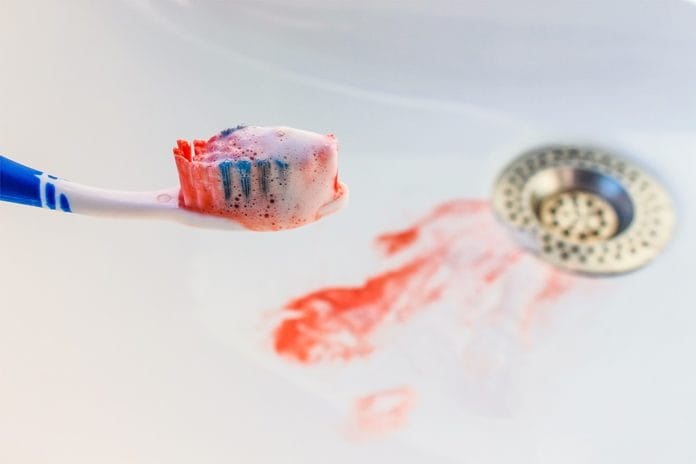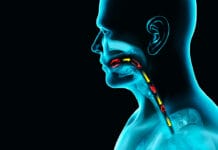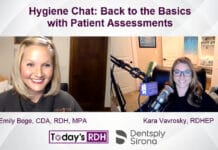Let’s think about how many times we’ve heard the following chief complaints from our patients: “I have cold sensitivity,” “I’m noticing a dark spot close to my gum line (a.k.a. black triangle),” “I think I’m brushing too hard,” or, “I started flossing, and I noticed my gums starting to recede.” Raise your hand if you have heard any of these more times than you can count on all ten of your fingers.
We see gingival recession every day in clinical practice. It is the most common clinical situation observed in patient populations regardless of their age and ethnicity.1 Often we hear our patients say gingival recession is genetic or is caused by brushing too hard. To be quite honest (at one point in time), we probably blamed gingival recession on the same reasons. But is genetics and toothbrushing to blame for this situation?
It is important to note the etiology of gingival recession is multifactorial. Therefore, a single factor alone may not necessarily result in the development of gingival recession. There are two factors to consider when trying to determine the root cause of gingival recession: Precipitating factors and Predisposing factors. Precipitating factors are oral hygiene practices that may contribute to the occurrence of gingival recession. It’s a major consideration in our understanding of the etiology, prognosis, and treatment. Predisposing factors are conditions that may cause bone dehiscence/fenestration defects and are thought to increase the risk of developing gingival recession. The table below provides examples of precipitating and predisposing factors for gingival recession.3
| PRECIPITATING FACTORS 1, 2, 3 | PREDISPOSING FACTORS 1, 2, 3 |
|
|
With everything dental hygienists already do well, we follow the dental hygiene standard of care. Starting with oral hygiene and periodontal assessment, we must evaluate any possible precipitating and predisposing factors for gingival recession. The more data collected during the assessment allows us to formulate a dental hygiene diagnosis, in which we assess and suggest what we can do preventively in managing gingival recession by creating a plan. Once patients are educated on the causes of gingival recession, implement a preventive treatment that will work in the best interest of the patient. Once preventive treatment has been implemented, we evaluate and document for changes or concerns.
Consider a patient who has puffy, inflamed gingiva and mediocre home care. There is gingival recession present, but could it really be caused by brushing too hard? In the past few years, I have come to understand that toothbrush abrasion isn’t always the culprit in the crime of receding gingiva. I took a step back from focusing on periodontal numbers and oral hygiene status and started to ask my patients to close in their natural bite and saw a discrepancy in how teeth are aligned. Over time teeth shift not only mesially and distally, but buccally and lingually, therefore creating malpositioned teeth, which is a predisposing factor of gingival recession. Now that I’ve assessed the relationship between gingival recession and malpositioned teeth, I am able to suggest to my patients solutions which will work for them to help protect their bite from increasing gingival recession, whether it’s a night guard or an orthodontic solution.
It takes the perfect mixture of precipitating and predisposing factors to begin the process of gingival recession. Patients recognize when gingival recession is present, and it almost always affects how they feel about their smile, how it makes their teeth feel, and it may be worrisome because they may be in fear of losing additional tooth or gingival structure. The every day saying gingival recession is “normal” or “genetic” is bothersome because we hear it every day in practice that it will be “watched” or patients need to “be careful” when brushing their teeth. We can alleviate the worry for our patients by educating them on the cause of gingival recession when we know it’s more than genetics or toothbrush abrasion.
Before you leave, check out the Today’s RDH self-study CE courses. All courses are peer-reviewed and non-sponsored to focus solely on pure education. Click here now.
Listen to the Today’s RDH Dental Hygiene Podcast Below:
SEE ALSO: Getting Down to It: Gingival Recession and Sensitivity
DON’T MISS: A Dental Hygienists’ Refresher on Periodontal Probing
References
- Dominiak, M., Gedrange, T. (2014). New perspectives in the diagnostic of gingival recession. Adv Clin Exp Med, Vol 23(6), 857-863. Retrieved from http://www.advances.umed.wroc.pl/pdf/2014/23/6/857.pdf
- Jati, A.S., Furqium, L.Z., Consolaro, A. (2016). Gingival recession: its causes and types, and the importance of orthodontic treatment. Dental Press Journal of Orthodontics, Vol 21(3), 18-29. Retrieved from http://dx.doi.org/10.1590/2177-6709.21.3.018-029.oin
- Chan, H, Chun, Y.P., MacEachern, M. (2015). Does gingival recession require surgical Dent Clin North Am, Vol 59(4), 981-996. Retrieved from https://www.ncbi.nlm.nih.gov/pmc/articles/PMC4907322/pdf/nihms790791.pdf












